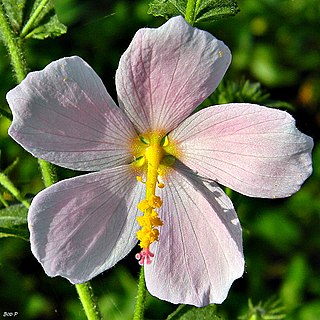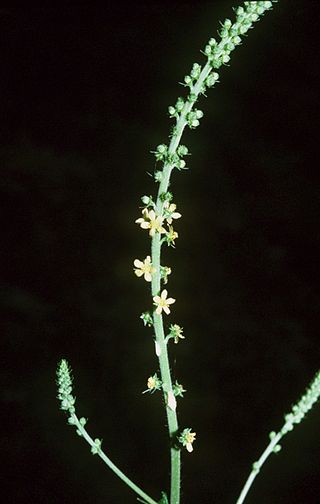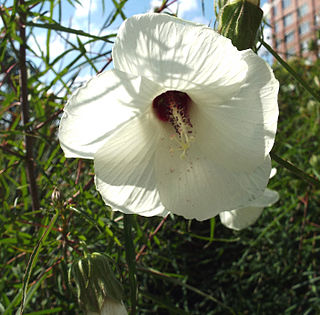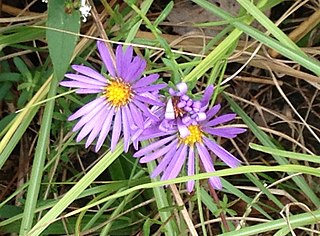
Trillium erectum, the red trillium, also known as wake robin, purple trillium, bethroot, or stinking benjamin, is a species of flowering plant in the family Melanthiaceae. The plant takes its common name "wake robin" by analogy with the European robin, which has a red breast heralding spring. Likewise Trillium erectum is a spring ephemeral plant whose life-cycle is synchronized with that of the forests in which it lives. It is native to the eastern United States and eastern Canada from northern Georgia to Quebec and New Brunswick.

Hibiscus is a genus of flowering plants in the mallow family, Malvaceae. The genus is quite large, comprising several hundred species that are native to warm temperate, subtropical and tropical regions throughout the world. Member species are renowned for their large, showy flowers and those species are commonly known simply as "hibiscus", or less widely known as rose mallow. Other names include hardy hibiscus, rose of sharon, and tropical hibiscus.

Kosteletzkya pentacarpos, the seashore mallow, also known as the saltmarsh mallow, sweat weed, Virginia saltmarsh mallow, or hibiscus à cinq carpelles, is an herb found in marshes along the eastern seashore of North America, parts of coastal Southern Europe, southwestern Russia, and Western Asia.

Hibiscus syriacus is a species of flowering plant in the mallow family, Malvaceae. It is native to south-central and southeast China, but widely introduced elsewhere, including much of Asia, both in the east and the west. It was given the epithet syriacus because it had been collected from gardens in Syria. Common names include the rose of Sharon,, Syrian ketmia, shrub althea, and rose mallow. It is the national flower of South Korea and is mentioned in the South Korean national anthem.
Hawaiian hibiscus are seven species of hibiscus native to Hawaii. The yellow hibiscus is Hawaii's state flower. Most commonly grown as ornamental plants in the Hawaiian Islands are the non-native Chinese hibiscus and its numerous hybrids, though the native Hibiscus arnottianus is occasionally planted.

Drosera capillaris, also known as the Pink Sundew is a species of carnivorous plant belonging to the family Droseraceae. It is native to the Southern United States, the Greater Antilles, Eastern and Southern Mexico, Central America, and Northern South America. It is listed as vulnerable in the US state of Virginia, and critically imperiled in Arkansas, Maryland, and Tennessee.

Hibiscus laevis, the halberd-leaf rosemallow, is a herbaceous perennial flower native to central and eastern North America. Their showy, creamy-white or pink flowers are large, up to 15 centimetres (6 in) across, and are hard to miss. These flowers require exposure to sunlight to open up properly, and then last only a single day.

Hibiscus waimeae is a species of flowering plant within the okra family, Malvaceae, that is endemic to the island of Kauaʻi in Hawaii.

Hibiscus moscheutos, the rose mallow, swamp rose-mallow, crimsoneyed rosemallow, or eastern rosemallow, is a species of flowering plant in the family Malvaceae. It is a cold-hardy perennial wetland plant that can grow in large colonies. The hirsute leaves are of variable morphology, but are commonly deltoidal in shape with up to three lobes. It is found in wetlands and along the riverine systems of the eastern United States from Texas to the Atlantic states, its territory extending northward to southern Ontario.

Hibiscus mutabilis, also known as the Confederate rose, Dixie rosemallow, cotton rose or cotton rosemallow, is a plant long cultivated for its showy flowers. Originally native to southern China, it is now found on all continents except Antarctica.

Hibiscus coccineus, the scarlet rosemallow, is a hardy Hibiscus species, also known as Texas star, brilliant hibiscus and scarlet hibiscus.

Hibiscus schizopetalus is a species of Hibiscus native to tropical eastern Africa in Kenya, Tanzania and Mozambique. Its common names include fringed rosemallow, Japanese lantern, coral hibiscus, and spider hibiscus.

Hibiscus denudatus is a perennial shrub of the mallow family, Malvaceae. It is in the rosemallow genus, Hibiscus.

Malus angustifolia, or southern crabapple, is a species of crabapple native to the eastern and south-central United States.

Agoseris aurantiaca is a species of plant in the family Asteraceae, commonly called orange agoseris or mountain dandelion. It is widespread in western North America.

Agrimonia parviflora is a species of perennial herbaceous flowering plant. Small-flowered agrimony, harvestlice agrimony, swamp agrimony, and harvestlice are its most common names in the United States.

Hibiscus striatus, the striped hibiscus or striped rosemallow, is a plant in the mallow family, Malvaceae. Its flowers are 5 inches across, some of the largest flowers of any mallow plant.

Hibiscus dasycalyx is a species of hibiscus known by the common name Neches River rosemallow. It is endemic to Texas in the United States, where there are three remaining natural populations and three introduced populations.

Symphyotrichum grandiflorum, the largeflower aster, is a species of flowering plant in the family Asteraceae. It is endemic to the southeastern United States where it is restricted to the Atlantic coastal plain of Virginia, North Carolina, and South Carolina, and the Piedmont of North Carolina and South Carolina. It is known from habitats such as sandy areas, roadsides, thickets, and forest edges. It can be distinguished from other Symphyotrichum species by its taller and hairier stems, clasping lower leaves, and large, showy flower heads. It is possibly threatened by habitat destruction within its restricted range but is still considered locally abundant in many areas such as the southern Appalachian Mountains.

Hibiscus coulteri, the desert rosemallow, is a species of flowering plant in the family Malvaceae. It is native to steep slopes and canyon walls in the eastern Sonoran Desert, and the Chihuahuan Desert of the southwestern US and northern Mexico. A short-lived perennial shrub reaching 6 ft (1.8 m), it is recommended for xeriscaping.



















